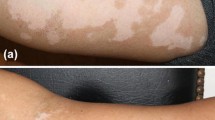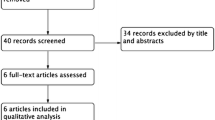Abstract
Facial vitiligo has considerable psychological and emotional impacts. Though topical corticosteroids are the mainstay treatment, adverse reactions are a concern for prolonged use. Additionally, 308-nm excimer lamps have been widely used in vitiligo. This study aimed to assess the effectiveness of a combined 308-nm excimer lamp and topical steroid therapy compared with the lamp alone for treating facial vitiligo. Symmetrical, nonsegmental facial vitiligo subjects were recruited. All facial lesions were irradiated with a 308-nm excimer lamp twice weekly for a total of 24 sessions. The lesions on each side of the face were randomly allocated to have topical mometasone furoate cream or the cream base alone applied once daily for 12 weeks. Clinical improvement was evaluated by a blinded dermatologist and the participants. A total of sixteen sides of the face were assessed in the study. By the 12th week, 87.5% of the lesions treated with the combination regimen and 50% of the lesions treated with monotherapy showed good to excellent repigmentation. From the subjects’ perspectives, there were significant differences between both treatments at week 4 and week 8 (p = 0.05) but not at week 12. No serious adverse effects were reported. A combination of excimer lamp therapy and once-daily application of topical mometasone cream was effective and could accelerate the treatment outcomes without serious adverse reactions. This may be an alternative regimen for treating facial vitiligo.


Similar content being viewed by others
References
Alikhan A, Felsten LM, Daly M, Petronic-Rosic V (2011) Vitiligo: a comprehensive overview part I. Introduction, epidemiology, quality of life, diagnosis, differential diagnosis, associations, histopathology, etiology, and work-up. J Am Acad Dermatol 65(3):473–491. https://doi.org/10.1016/j.jaad.2010.11.061
Rodrigues M, Ezzedine K, Hamzavi I, Pandya AG, Harris JE, Vitiligo Working G (2017) New discoveries in the pathogenesis and classification of vitiligo. J Am Acad Dermatol 77(1):1–13. https://doi.org/10.1016/j.jaad.2016.10.048
Bae JM, Lee SC, Kim TH, Yeom SD, Shin JH, Lee WJ, Lee MH, Lee AY, Kim KH, Kim MB, Park CJ, Lee SH, Kim DH, Lee HJ, Lee DY, Choi CW, Kim YC, Kang HY, Haw S, Lee YB, Yun SJ, Yun SK, Hong SP, Lee Y, Kim HJ, Choi GS (2018) Factors affecting quality of life in patients with vitiligo: a nationwide study. Br J Dermatol 178(1):238–244. https://doi.org/10.1111/bjd.15560
Sarkar S, Sarkar T, Sarkar A, Das S (2018) Vitiligo and psychiatric morbidity: a profile from a vitiligo clinic of a rural-based tertiary care center of eastern India. Indian J Dermatol 63(4):281–284. https://doi.org/10.4103/ijd.IJD_142_18
Felsten LM, Alikhan A, Petronic-Rosic V (2011) Vitiligo: a comprehensive overview part II: treatment options and approach to treatment. J Am Acad Dermatol 65(3):493–514. https://doi.org/10.1016/j.jaad.2010.10.043
Ohguchi R, Kato H, Furuhashi T, Nakamura M, Nishida E, Watanabe S, Shintani Y, Morita A (2015) Risk factors and treatment responses in patients with vitiligo in Japan--a retrospective large-scale study. Kaohsiung J Med Sci 31(5):260–264. https://doi.org/10.1016/j.kjms.2015.02.003
Brazzelli V, Antoninetti M, Palazzini S, Barbagallo T, De Silvestri A, Borroni G (2007) Critical evaluation of the variants influencing the clinical response of vitiligo: study of 60 cases treated with ultraviolet B narrow-band phototherapy. J Eur Acad Dermatol Venereol 21(10):1369–1374. https://doi.org/10.1111/j.1468-3083.2007.02278.x
Kruger C, Schallreuter KU (2012) A review of the worldwide prevalence of vitiligo in children/adolescents and adults. Int J Dermatol 51(10):1206–1212. https://doi.org/10.1111/j.1365-4632.2011.05377.x
Park KK, Liao W, Murase JE (2012) A review of monochromatic excimer light in vitiligo. Br J Dermatol 167(3):468–478. https://doi.org/10.1111/j.1365-2133.2012.11008.x
Hong SB, Park HH, Lee MH (2005) Short-term effects of 308-nm xenon-chloride excimer laser and narrow-band ultraviolet B in the treatment of vitiligo: a comparative study. J Korean Med Sci 20(2):273–278. https://doi.org/10.3346/jkms.2005.20.2.273
Passeron T, Ostovari N, Zakaria W, Fontas E, Larrouy JC, Lacour JP, Ortonne JP (2004) Topical tacrolimus and the 308-nm excimer laser: a synergistic combination for the treatment of vitiligo. Arch Dermatol 140(9):1065–1069. https://doi.org/10.1001/archderm.140.9.1065
Kawalek AZ, Spencer JM, Phelps RG (2004) Combined excimer laser and topical tacrolimus for the treatment of vitiligo: a pilot study. Dermatol Surg 30(2 Pt 1):130–135
Mouzakis JA, Liu S, Cohen G (2011) Rapid response of facial vitiligo to 308nm excimer laser and topical calcipotriene. J Clin Aesthet Dermatol 4(6):41–44
Li L, Liang Y, Hong J, Lan L, Xiao H, Xie Z (2019) The effectiveness of topical therapy combined with 308-nm excimer laser on vitiligo compared to excimer laser monotherapy in pediatric patients. Pediatr Dermatol 36(1):e53–e55. https://doi.org/10.1111/pde.13726
Shi Q, Li K, Fu J, Wang Y, Ma C, Li Q, Li C, Gao T (2013) Comparison of the 308-nm excimer laser with the 308-nm excimer lamp in the treatment of vitiligo--a randomized bilateral comparison study. Photodermatol Photoimmunol Photomed 29(1):27–33. https://doi.org/10.1111/phpp.12015
Le Duff F, Fontas E, Giacchero D, Sillard L, Lacour JP, Ortonne JP, Passeron T (2010) 308-nm excimer lamp vs. 308-nm excimer laser for treating vitiligo: a randomized study. Br J Dermatol 163(1):188–192. https://doi.org/10.1111/j.1365-2133.2010.09778.x
Salah Eldin MM, Sami NA, Aly DG, Hanafy NS (2017) Comparison between (311-312 nm) narrow band ultraviolet-B phototherapy and (308 nm) monochromatic excimer light phototherapy in treatment of vitiligo: a histopathological study. J Lasers Med Sci 8(3):123–127. https://doi.org/10.15171/jlms.2017.22
Novak Z, Berces A, Ronto G, Pallinger E, Dobozy A, Kemeny L (2004) Efficacy of different UV-emitting light sources in the induction of T-cell apoptosis. Photochem Photobiol 79(5):434–439
Sassi F, Cazzaniga S, Tessari G, Chatenoud L, Reseghetti A, Marchesi L, Girolomoni G, Naldi L (2008) Randomized controlled trial comparing the effectiveness of 308-nm excimer laser alone or in combination with topical hydrocortisone 17-butyrate cream in the treatment of vitiligo of the face and neck. Br J Dermatol 159(5):1186–1191. https://doi.org/10.1111/j.1365-2133.2008.08793.x
Li L, Hong J, Lan L, Xie Z, Liang Y, Chen H, Pan N (2019) The effectiveness of combination therapy with 308-nm excimer laser in vitiligo in Han Chinese people. Australas J Dermatol 60(1):e85–e86. https://doi.org/10.1111/ajd.12883
Bapur Erduran F, Adisen E (2016) Comparison of the efficacy of 308-nm excimer lamp monotherapy with topical tacrolimus or clobetasol 17-propionate combination therapies in localized vitiligo. Photodermatol Photoimmunol Photomed 32(5–6):247–253. https://doi.org/10.1111/phpp.12266
Kanokrungsee S, Chanprapaph K, Chaiyabutr C, Vachiramon V (2016) A comparative study of combined treatment with fractional carbon dioxide and targeted ultraviolet B phototherapy for facial vitiligo. Lasers Med Sci 31(7):1343–1349. https://doi.org/10.1007/s10103-016-1982-z
Funding
This study was supported by Thammasat University Research Fund, Contract No. TUFT 24/2562.
Author information
Authors and Affiliations
Corresponding author
Ethics declarations
Conflict of interest
The authors declare that they have no conflict of interest.
Ethical approval
This study has been approved by the Thammasat University Institutional Review board and followed the ethical guidelines of the 1975 Declaration of Helsinki.
Informed consent
Informed consent was obtained from all individual participant included in the study before participating in the study.
Additional information
Publisher’s note
Springer Nature remains neutral with regard to jurisdictional claims in published maps and institutional affiliations.
Rights and permissions
About this article
Cite this article
Juntongjin, P., Toncharoenphong, N. Effectiveness of a combined 308-nm excimer lamp and topical mid-potent steroid treatment for facial vitiligo: a preliminary, randomized double-blinded controlled study. Lasers Med Sci 35, 2023–2029 (2020). https://doi.org/10.1007/s10103-020-03048-5
Received:
Accepted:
Published:
Issue Date:
DOI: https://doi.org/10.1007/s10103-020-03048-5




